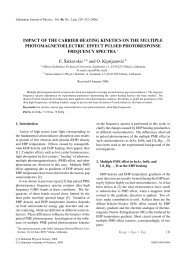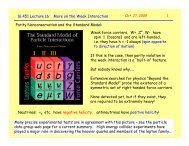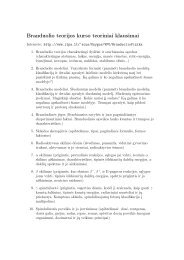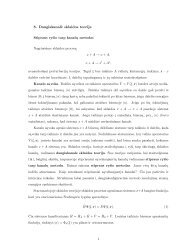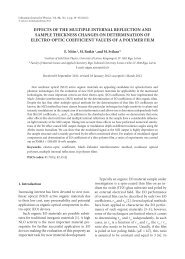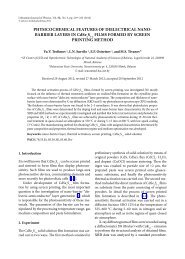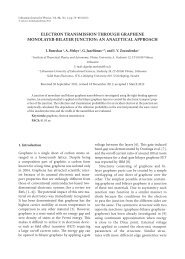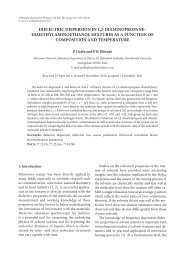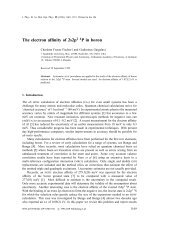Gale - Science and Its Times Vol 01 (2000 BC to AD 699).pdf
Gale - Science and Its Times Vol 01 (2000 BC to AD 699).pdf
Gale - Science and Its Times Vol 01 (2000 BC to AD 699).pdf
You also want an ePaper? Increase the reach of your titles
YUMPU automatically turns print PDFs into web optimized ePapers that Google loves.
type of dress or robe. The most fascinating <strong>and</strong><br />
controversial figure on the reliefs is the queen<br />
of Punt who is depicted with an exaggerated<br />
swayback <strong>and</strong> rolls of fat covering her arms <strong>and</strong><br />
short legs. The peculiar, but precise, portrayal<br />
of the queen of Punt has led many scholars <strong>to</strong><br />
suggest that she suffered from a variety of serious<br />
medical conditions, although it may be<br />
that the Egyptians were simply impressed by<br />
her enormous size <strong>and</strong> wanted <strong>to</strong> record it accurately.<br />
In addition <strong>to</strong> people, the Punt reliefs<br />
show villages <strong>and</strong> surrounding flora <strong>and</strong> fauna.<br />
The typical Puntite village was located on the<br />
banks of a river where round, domed, mud<br />
huts were built on piers <strong>to</strong> keep them free of<br />
the river’s floodwaters <strong>and</strong> safe from snakes,<br />
crocodiles, <strong>and</strong> hippos. L<strong>and</strong>scape features,<br />
plants, <strong>and</strong> animals included on the reliefs<br />
suggest that Punt was located in the hilly savannah<br />
country west of the Red Sea. Because<br />
no one has attempted <strong>to</strong> excavate in this area,<br />
many questions remain about the Puntite culture<br />
<strong>and</strong> its trade with Egypt. The Egyptians<br />
themselves apparently did not have a permanent<br />
camp in Punt, although Hatshepsut built<br />
a small shrine there in honor of the god Amun<br />
<strong>and</strong> the queen of Punt.<br />
The Punt expedition provided Egypt with<br />
numerous luxury items. Most in dem<strong>and</strong> were<br />
aromatic resins, myrrh <strong>and</strong> frankincense, which<br />
the Egyptians used for religious ceremonies. The<br />
Egyptians even brought back myrrh trees, their<br />
root balls protected in baskets, <strong>to</strong> be replanted at<br />
various temples. Other desirable commodities<br />
included panther, leopard, <strong>and</strong> cheetah skins;<br />
ivory; ebony; gold; live animals such as baboons<br />
<strong>and</strong> cattle; semiprecious s<strong>to</strong>nes; <strong>and</strong> spices. Not<br />
all these items were native <strong>to</strong> Punt, but were<br />
gathered further inl<strong>and</strong> by the Puntites expressly<br />
for the Egyptian trade. In return, the Egyptians<br />
traded beer, wine, fruit, meat, jewelry, weapons,<br />
<strong>and</strong> other small items. The Egyptian economy<br />
obviously profited hugely from this trade, since<br />
much of what they brought back <strong>to</strong> Egypt was<br />
distributed <strong>to</strong> temples, private individuals, <strong>and</strong><br />
the Byblos trade, or was given in exchanges of<br />
gifts with foreign rulers.<br />
Hatshepsut’s Punt expedition reestablished<br />
an important <strong>and</strong> lucrative trade. It is possible<br />
that Egypt exercised some form of authority over<br />
Punt, although the essential character of their relationship<br />
remained mercantile, rather than political.<br />
It would have been nearly impossible <strong>to</strong><br />
rule Punt effectively from such a distance. On the<br />
other h<strong>and</strong>, the fact that Punt was located <strong>to</strong>o far<br />
away <strong>to</strong> pose a threat <strong>to</strong> Egypt was probably very<br />
attractive <strong>to</strong> the Egyptians, who were always concerned<br />
about foreign invasion. Distance also<br />
added an element of fascination <strong>and</strong> adventure <strong>to</strong><br />
the association. Quite simply, the Egyptians felt<br />
that they were traveling “<strong>to</strong> the ends of Earth“ in<br />
order <strong>to</strong> gain un<strong>to</strong>ld riches <strong>and</strong> arcane knowl-<br />
MYTHS REVEALED AS TRUTH:<br />
WHEN THE EXPERTS ARE WRONG<br />
<br />
Exploration<br />
& Discovery<br />
<strong>2000</strong> B.C.<br />
<strong>to</strong> A.D. <strong>699</strong><br />
Agreat deal of what is known <strong>to</strong>day about the ancient world<br />
represents the triumph of the amateur over the professional, or<br />
of what first seemed <strong>to</strong> be myth over apparent scientific skepticism.<br />
An example of the former was the 1952 translation of the<br />
Mycenaean script known as Linear B, an effort begun by an architect<br />
named Michael Ventris (1922-1956). Though he completed his translation<br />
with the help of a professional linguist, John Chadwick, much<br />
of the deciphering work had already been completed by Ventris—<br />
who, though knowledgeable in areas such as statistical analysis, was<br />
far from an expert on Mycenae.<br />
As for the idea of seeming myth triumphing over skepticism, a<br />
variety of information related in the Bible has turned out <strong>to</strong> be<br />
accurate his<strong>to</strong>rical data. At one point his<strong>to</strong>rians, rejecting the biblical<br />
Creation s<strong>to</strong>ry, were ready <strong>to</strong> throw out the proverbial baby with the<br />
bath water, rejecting David <strong>and</strong> Solomon—not <strong>to</strong> mention Abraham<br />
<strong>and</strong> Moses—as figures no more his<strong>to</strong>rical than Achilles or Heracles.<br />
In fact it now appears that virtually all biblical figures after Noah were<br />
real human beings.<br />
A particularly interesting case was that of the Hittites of Asia<br />
Minor, who, though mentioned in the Bible, were unknown <strong>to</strong> their<br />
next-door neighbors in Greece. In the nineteenth century,<br />
archaeologists established the Hittite civilization as his<strong>to</strong>rical fact,<br />
<strong>and</strong> discovered the reason why the Greeks had never heard of them:<br />
the Hittites disappeared in c. 1200 B.C., about the time Mycenaean<br />
Greece was plunged in<strong>to</strong> a dark age following the Dorian invasion.<br />
One s<strong>to</strong>ry that brings <strong>to</strong>gether all the above threads— mythology<br />
as fact, the brilliant amateur, <strong>and</strong> the layers of his<strong>to</strong>ry in Greece <strong>and</strong><br />
Asia Minor—is that of Heinrich Schliemann (1822-1890). Among the<br />
few joys of his poverty-stricken childhood had been a book of tales<br />
about the Trojan War, which everyone at the time assumed <strong>to</strong> be a<br />
myth. But not Schliemann: after amassing a great deal of wealth as a<br />
merchant, he set off for Turkey <strong>to</strong> find the ancient home of the Trojans.<br />
Not only did he discover Troy (under present-day Hissarlik), but he<br />
eventually uncovered much of Mycenae.<br />
JUDSON KNIGHT<br />
S C I E N C E A N D I T S T I M E S V O L U M E 1<br />
7




